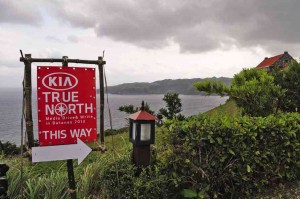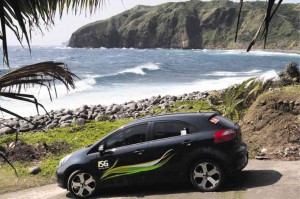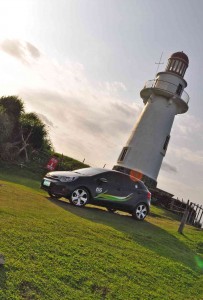Batan island in the province of Batanes is so remote that one has to time his or her trip on weeks that a typhoon or any weather disturbance for that matter is not expected.
Shipping goods, much more vehicles, is equally tough. In the case of Columbian Autocar Corp., the company had to drive more than a dozen Kia vehicles to Sual Port in Pangasinan and then take a 48-hour trip to Basco Port in Batan, braving the notoriously choppy waters of Balintang Channel, along the way.
“They say it can’t be done. That Batanes is too remote and risky to organize an event of this magnitude. But we proved that this could be done,” said CAC marketing services head Palermo Soriano as he welcomed the 40 members of the Motoring media who joined the Kia True North Media Ride and Write in Batanes 2013.
Look at different angle
Indeed, just like the company that loves to churn out innovatively designed vehicles, the event challenged the participants to look at things on a different angle: Take a photo of each of the chosen 10 best sights of Batan island (with a Kia vehicle, of course) and make sure that these pictures stand out from the rest of the competing teams.
For this event Kia shipped in a dozen of its finest models raging from the diminutive Picanto to the great all-rounder Sorento crossover.
Assigned to a black Rio Hatchback equipped with Kia’s new Idle Stop & Go (ISG) technology—the only one available at the moment in the Philippines—our team first proceeded to the panoramic Rolling Hills of Vayang, then to the iconic Basco Lighthouse, the 224-year-old Mahatao Church, the weather outpost called Tukon Radar Station, and the spell-binding Boulder Beach of Valugan.

THIS would be the first time an automotive brand organized a major ride and drive event in Batanes. photo: EDWIN BACASMAS
After taking our lunch break, we then proceeded to the naturally sculpted Alapad rock formation along Itbud Highway, the historic Ivana Church, the 126-year-old house of Dakay Estrella (one of the five oldest surviving stone houses in the province), the Pacific Ocean-facing Tayid Lighthouse and lastly, the scenic pastureland called Marlboro Hills.
Like the places we’ve visited and took pictures of, we were also all praises to the car assigned to our team: the Rio Hatch ISG not only looks sharp but it features a function that that is much needed when driving in typically heavy traffic conditions and constant stop-start motoring.
The ISG technology automatically turn the Rio Hatch’s 1.4 liter engine off whenever the car stops moving, its 6-speed manual gearbox is put into neutral, the foot is removed from the clutch or while moving forward at less than 4 kph. The engine restarts automatically whenever the clutch is engaged.
Less fuel and emission
This interesting technology enables the Rio Hatch ISG to dramatically lessen fuel consumption and emission by as much as 15 percent (it returned a respectable 10 km per liter fuel consumption despite the frequent spirited driving along the island’s almost empty coastal roads).
Kia’s ISG technology uses a “smart” starter motor which is linked to a vehicle’s on-board computer (or the ECU). When the driver comes to a stop (or is even moving forward at a speed below 4 kph), the ECU uses information from various other control systems in the car (if the transmission is in neutral and the clutch released) to decide if it is appropriate to switch the engine off.
However, with this system, the available battery power must be above 75 percent of maximum. Otherwise, the computer will not activate the ISG function, for safety reasons.
Get brand attention
Kia’s approach in taking a lead role in introducing innovative approaches to its cars suits well for a company that has gone from being a little-known South Korean brand a few years ago to being a full-fledged automotive brand that is getting everyone’s attention.
Many Filipinos may have surely noted the new-model onslaught that CAC has conducted over the last three years, launching several all-new or face-lifted Kia models up to the end of 2012.
Also, one cannot ignore the recent aesthetic shift in Kia’s product range, due in no small part to the efforts of German design director Peter Schreyer who took the brand into a more stylistically appealing arena.
Well, CAC isn’t about to lift off the gas just yet as more new or revised products sporting the now familiar “Tiger Nose” grille are set to debut in the coming months (the Rio Hatch ISG as well as the much anticipated Carens compact MPV are just two of the model introductions we should expect).
Indeed, Kia knows exactly how to achieve its goal of becoming one of the most recognizable brand names in the markets it is competing on.
“Keep your eyes on Kia because our best has yet to come,” teased CAC president Ginia Domingo.
With what CAC has accomplished in Batanes, Kia may perhaps be nearing its goal here in the Philippines.



